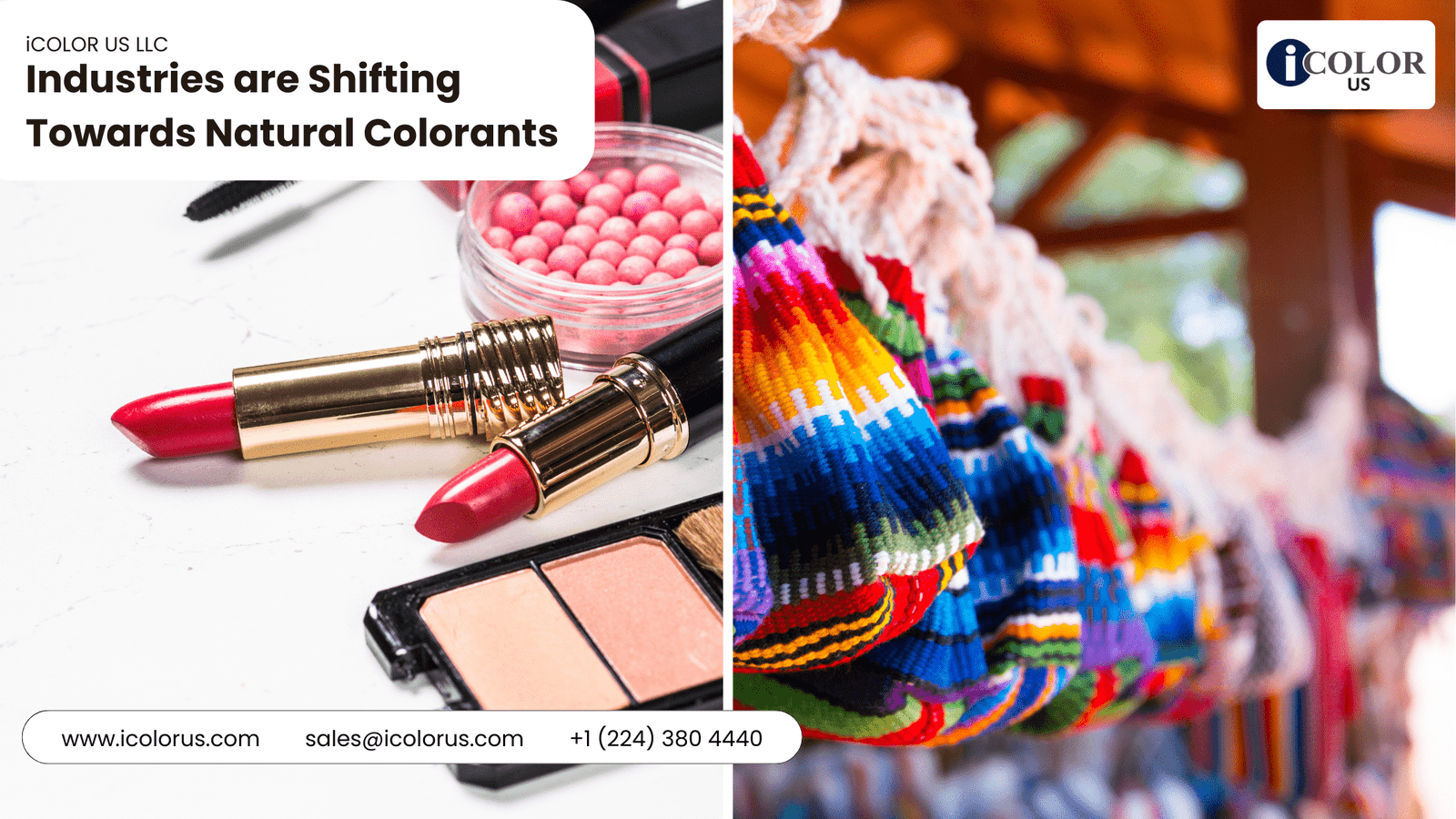Natural Colorants: Industries are Shifting
In recent years, there has been a significant shift in industries toward the use of natural colorants. This change is driven by a combination of consumer demand, regulatory pressure, and a growing awareness of the environmental and health impacts associated with synthetic dyes. Natural colorants, derived from plants, minerals, and other natural sources, are becoming increasingly popular across various sectors, including food and beverages, cosmetics, textiles, and pharmaceuticals. This article explores the reasons behind this shift, supported by industry statistics and insights.
The Rise of Consumer Awareness and Demand
One of the primary drivers behind the shift towards natural colorants is the increasing consumer awareness of health and environmental issues. Today’s consumers are more informed than ever about the ingredients in the products they purchase and are actively seeking out more natural and sustainable options.
Health Concerns
Numerous studies have highlighted the potential health risks associated with synthetic dyes, including allergic reactions, hyperactivity in children, and links to certain cancers. For instance, the Center for Science in the Public Interest (CSPI) has called for bans on artificial food dyes due to their potential health risks. As a result, consumers are demanding safer alternatives, and industries are responding by switching to natural colorants.
Environmental Impact
The production of synthetic dyes is often associated with significant environmental pollution. The textile industry, for example, has been criticized for its heavy reliance on synthetic dyes, which contribute to water pollution and other environmental hazards. Natural colorants, on the other hand, are typically more biodegradable and less harmful to the environment. According to a report by the Ellen MacArthur Foundation, transitioning to more sustainable dyeing processes, including the use of natural dyes, could significantly reduce the environmental footprint of the fashion industry.
Regulatory Pressure
Governments and regulatory bodies around the world are tightening regulations on synthetic dyes due to their potential health and environmental impacts. In the European Union, for example, several artificial food colorants are banned or restricted. Similarly, the U.S. Food and Drug Administration (FDA) has specific regulations for the use of color additives in foods, drugs, and cosmetics. These regulatory pressures are pushing industries to seek safer, more compliant alternatives, such as natural colorants.
Advances in Technology and Innovation
Advances in extraction and processing technologies have made natural colorants more viable and cost-effective for industrial use. Innovations in biotechnology, for instance, have improved the stability, color range, and application of natural dyes, making them competitive with synthetic options. Companies are investing in research and development to enhance the performance of natural colorants, ensuring they meet industry standards for color consistency, shelf life, and safety.
Industry Applications and Benefits
Food and Beverage Industry
The food and beverage industry has been one of the earliest adopters of natural colorants. Consumers are increasingly seeking clean label products, which are free from artificial additives and preservatives. Natural colorants derived from fruits, vegetables, and spices not only appeal to health-conscious consumers but also offer unique flavors and nutritional benefits. For example, beetroot powder is used for its vibrant red color and its nutritional content, including vitamins and antioxidants.
Cosmetics and Personal Care
The cosmetics and personal care industry is also experiencing a significant shift towards natural colorants. With the growing trend of organic and natural beauty products, consumers are looking for safer, non-toxic alternatives to synthetic dyes. Natural colorants such as henna, turmeric, and carmine are widely used in hair dyes, makeup, and skincare products. These ingredients not only provide beautiful, vibrant colors but also offer skin benefits, such as anti-inflammatory and antioxidant properties.
Textile Industry
The textile industry, traditionally reliant on synthetic dyes, is increasingly exploring natural colorants as part of a broader movement towards sustainability. Natural dyes, sourced from plants, insects, and minerals, offer a more environmentally friendly alternative to synthetic options. Brands and designers are experimenting with natural dyeing techniques to create unique, eco-friendly fashion lines. According to the Textile Exchange, the demand for organic and sustainable textiles is on the rise, with more companies committing to environmentally responsible practices.
Pharmaceuticals
In the pharmaceutical industry, natural colorants are used not only for aesthetic purposes but also for their potential therapeutic benefits. For instance, curcumin, derived from turmeric, is used for its anti-inflammatory properties and its vibrant yellow color. The use of natural colorants in pharmaceuticals aligns with the industry’s focus on patient safety and product efficacy.
Challenges and Solutions
While the shift towards natural colorants offers numerous benefits, it also presents challenges that industries must address.
Cost and Availability
Natural colorants can be more expensive and less readily available than their synthetic counterparts. However, economies of scale and advancements in cultivation and extraction techniques are helping to reduce costs and improve supply chains. Companies are also exploring sustainable sourcing practices to ensure a steady supply of raw materials.
Stability and Performance
Natural colorants can be less stable and consistent than synthetic dyes, which can impact product quality. To address this, researchers are developing methods to enhance the stability and performance of natural colorants. Encapsulation techniques, for example, can protect natural pigments from degradation and improve their shelf life.
Regulatory Compliance
Navigating the regulatory landscape for natural colorants can be complex, as different countries have varying requirements and standards. Companies must invest in regulatory expertise to ensure their products comply with local and international regulations. Collaboration with regulatory bodies can also facilitate the approval process for new natural colorants.
Case Studies and Success Stories
Cosmetics: Lush
Lush, a global cosmetics company known for its ethical and sustainable practices, has been a pioneer in the use of natural colorants. The company’s product range includes vibrant bath bombs, soaps, and cosmetics colored with natural ingredients like henna, turmeric, and plant extracts. Lush’s commitment to natural colorants aligns with its brand values and appeals to environmentally conscious consumers.
Textiles: Patagonia
Patagonia, an outdoor clothing and gear company, is renowned for its environmental advocacy and sustainable practices. The company has been exploring natural dyeing techniques to reduce its environmental impact. Patagonia’s use of plant-based dyes and commitment to transparency in its supply chain sets an example for the textile industry.
The Future of Natural Colorants
The trend towards natural colorants is expected to continue growing as industries, consumers, and regulators increasingly prioritize health, sustainability, and safety. As technology advances and the availability of natural colorants improves, more companies are likely to adopt these alternatives. The shift towards natural colorants represents a significant step towards a more sustainable and responsible future across various industries.
Conclusion
The shift towards natural colorants is driven by a combination of consumer demand, regulatory pressure, and technological advancements. Natural colorants offer a safer and more sustainable alternative to synthetic dyes, with applications across food and beverages, cosmetics, textiles, and pharmaceuticals. Despite challenges such as cost and stability, the benefits of natural colorants make them an attractive choice for industries looking to meet the demands of today’s health-conscious and environmentally aware consumers. As the market for natural colorants continues to grow, companies like iCOLOR US LLC are at the forefront of this transformative movement, providing innovative solutions that align with the values of sustainability and safety.





